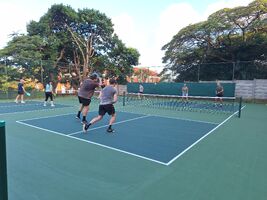
About Pickleball
Origin: Pickleball was invented in 1965 on Bainbridge Island, Washington, USA, by three friends: Joel Pritchard, Bill Bell, and Barney McCallum.
Court Size: Pickleball is typically played on a rectangular court, which is divided into two halves by a net.
Equipment: Players use solid paddles made of wood or composite materials to hit a perforated polymer ball, similar to a wiffle ball. The ball has 40 round holes and is about the size of a baseball.
Scoring: Pickleball is usually played to 11 points, and the winning team must win by at least two points. Points are scored only by the serving team.
Serve: The serve in pickleball must be made underhand, and the server must keep both feet behind the baseline when serving. The ball must be served diagonally to the opponent's service court.
Dinking: Dinking is a strategy used in pickleball where players hit the ball softly over the net and into the opponent's kitchen (the non-volley zone) to create a drop shot and control the pace of the game.
Non-Volley Zone: The non-volley zone, also known as the kitchen, is the area on each side of the net within seven feet from the net. Players are not allowed to volley the ball (hit it in the air without letting it bounce) while inside this zone.
Popularity: Pickleball has gained immense popularity due to its accessibility, ease of learning, and the ability to be played by people of all ages and skill levels. It's often played in schools, community centers, and retirement communities.
International Presence: While pickleball is more prominent in North America, it has been spreading globally. Tournaments and clubs are emerging in various countries, making it a truly international sport.
Community: One of the unique aspects of pickleball is its sense of community. Players often enjoy the social aspect of the game, and it's not uncommon for players to gather for post-game socializing.
